#peteinosaurus
Explore tagged Tumblr posts
Text
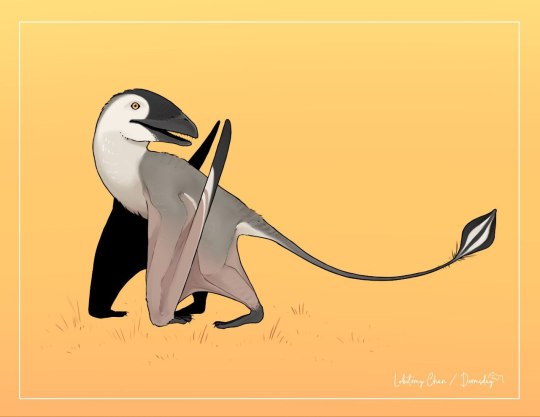
Peteinosaurus zambellii, a piscivore about the size of a magpie that lived during the Late Triassic. It is one of the oldest-known pterosaurs and compared to some later genera had a tiny wingspan, only twice the lenght of it's hindlimb.
I don't know why, but I'm in love with this drawing, even though I made it XD. For some reason I really like drawing tiny, spiky and gnarly teeth. The colours were based on the Long-tailed and the Willow tits.
#digital art#paleoart#paleoblr#original art#artists on tumblr#paleomedia#pterosaur#pterosaurs#peteinosaurus#triassic
348 notes
·
View notes
Text


Garsona or Pterosona .... choices must be made
#I made the gar one ages ago but I don't think I posted it here. I still like it though#peteinosaurus#gar#my art
399 notes
·
View notes
Text

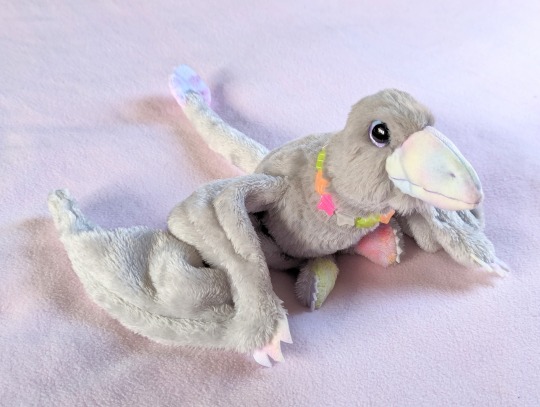


One pretty pastel peteinosaurus plushie is ready to adopt from Thylacine's Toyshop! This little pterosaur is so floppy and soft! I made it a wee necklace to match its bright feet too, just for fun.
#peteinosaurus#pterosaur#plushie#toys#artist plush#toy with accessories#grey#plushies for sale#prehistoric
206 notes
·
View notes
Text




More paleo artfights!!
Cody and Carpetback for SpiderNoob64 Rex, Beef Sausage, and Darryl for SpiderNoob64 Peebles for Thylacereal Sushi and SugarPop for Foxiane
#my art#artfight#artfight 2024#paleo#dinosaurs#carnotaurus#tyrannosaurus rex#deinonychus#baryonyx#pterosaur#peteinosaurus
60 notes
·
View notes
Text
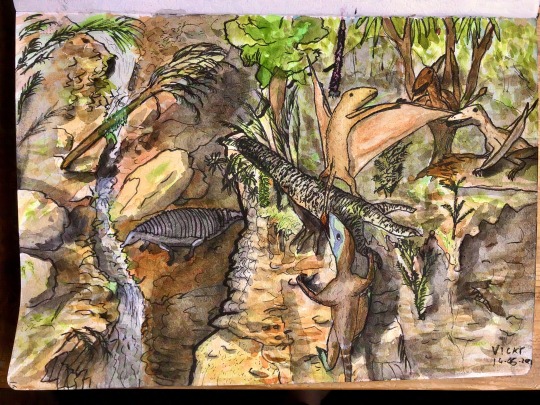
A Peteinosaurus shows off on a Williamsonia atop a small overgrown cliff, unaware of the Procompsognathus climbing the cliff to sneak up on him. Behind and below them, a Paratypothorax has come to her favourite stream to drink.
#peteinosaurus#procompsognathus#paratypothorax#pterosaur#dinosaur#coelophysid#theropod#aetosaur#pseudosuchian#triassic#paleoart#williamsonia#my art#palaeoblr#watercolour#cliffs#mountains
134 notes
·
View notes
Text



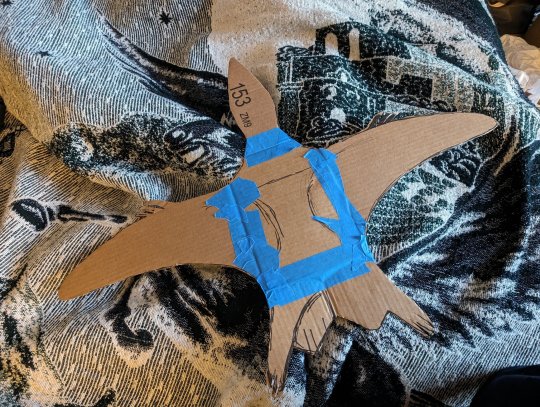
Peteinosaurus Model
17 notes
·
View notes
Text
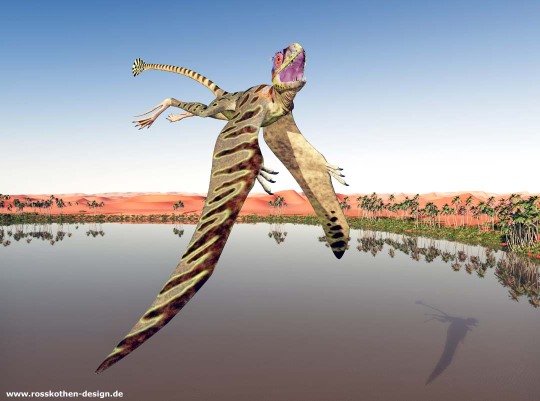
Pterosaur Peteinosaurus over a desert oasis
#dinosaurs#dinosaur#dinosaurier#dino#ilovedinosaurs#dinosaursarelife#dinosaursart#dinosaursareawesome#dinosaurslive#walkingwithdinosaurs#dinosaursparty#paleontology#digitalart#pterosaur#peteinosaurus#oasis#desert
3 notes
·
View notes
Text
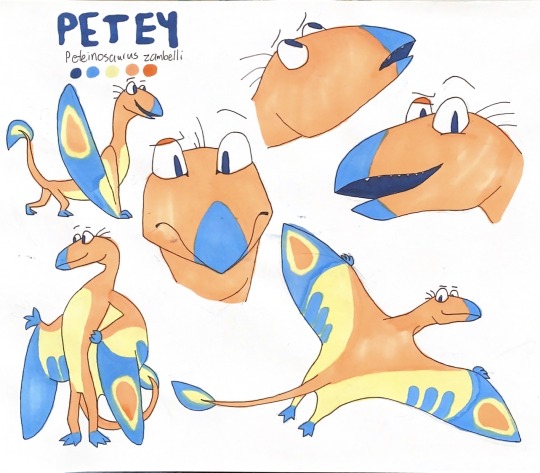
Petey the peteinosaurus! (Because what else would I call him?)
18 notes
·
View notes
Note
Peteinosaurus, Tapejara, Rhamphorynchus, Anurognathus, or Quetzalcoatlus from Walking with Dinosaurs?
Added, thank you!
4 notes
·
View notes
Note
Zoe, did you know I have a list of favorite dinosaurs, pterosaurs, marine reptiles and other prehistoric creatures? Here’s the list. They are Tyrannosaurus Rex, Dreadnoughtus, Deinonychus, Nothosaurus, Masiakasaurus, Eoraptor, Suchomimus, Sauroposeidon, Crichtonsaurus, Saurophaganax, Epidexipteryx, Olorotitan, Ornithomimus, Dracorex, Pterodaustro, Peteinosaurus, Pterodactylus, Regaliceratops, Einiosaurus, Kosmocratops, Attenboroughsaurus, Albertosaurus, Alexornis, Cryolophosaurus, Lexovisaurus, Megalosaurus, Dimetrodon, Devonynchus, Dunkleosteus, Sauropelta, Sinosauropteryx, Proganochelys, Isisaurus, Torvosaurus, Supersaurus, Ultrasaurus and Tarbosaurus.

zoe: i remember
3 notes
·
View notes
Note
Culler Gridlets are hateful little shits, they usually cling to the nearest red ranger.
Culler Gridlets are based off Dimorphodontids like Caviramus and Peteinosaurus.
YESSSSSS
I love them they're so cute
0 notes
Text
Here’s the script for A Prehistoric Mission.
One day, the Little Einsteins were in the American desert looking for dinosaur fossils. And sure enough, they found some! But they weren’t sure what dinosaurs they belonged to. That’s when Rocket changed into something new. His time machine mode! The Little Einsteins climbed aboard and Rocket blasted off! The giant clock began to spin its hands very fast and then, Rocket flew through time! And that’s when the Little Einsteins came to the Mesozoic era. They had blasted off millions and millions of years back in time! They found out they were in the Triassic period, which is why they saw Peteinosaurus, Eoraptor and Proganochelys. But June found out the fossil she found matches a Riojasaurus toe. Next, they went to the Jurassic period, where they saw Apatosaurus eating leaves. And then they saw a mommy Stegosaurus. Her babies have just hatched. But then they heard a loud roar! It was the roar of an Allosaurus! The Little Einsteins hid behind some nearby trees so that the Allosaurus wouldn’t see them. As they observed the Stegosaurus protecting her newly hatched babies, Quincy saw that his fossil was a Stegosaurus plate. After the Allosaurus left, Rocket felt something crawling on his roof. It was an Archaeopteryx. Rocket found out that the fossil he found is an Archaeopteryx skull. Lastly, they arrived at the Cretaceous period. They saw a Maiasaura feeding her babies some ABC plants, a pteranodon catching fish and even an Ankylosaurus sleeping by some flowers. Then they came across a herd of Triceratops. Leo found out the fossil he found was a Triceratops horn. June even happily fed a leaf to a baby Triceratops. But then, they heard a noise coming from the bushes. It was a pack of Velociraptors! Rocket gave the kids some special shields that looked like Triceratops, as well as their Ceratopsian cousins, Einiosaurus, Kosmoceratops, Regaliceratops and Styracosaurus. After the herd of Triceratops fended off the Velociraptor pack, Leo could see that Annie was sadly walking away. Leo followed her, determined to find his little sister. He saw an Enantiornithine, an Avisaurus, a Microraptor and an Argentinosaurus. But he soon found Annie. She was sitting in a Cretaceous pumpkin patch, watching the dragonflies, butterflies and honeybees. Leo asked Annie why she was sad. She told her brother that her fossil, which was a tooth, didn’t match the carnivores they saw. It didn’t match the Eoraptor, the Allosaurus, the Archaeopteryx, or the Velociraptor. Leo observed the fossilized tooth. He said it was as big as a banana. He told Annie that he and his friends will help her figure it out. That made Annie feel better. But then, the ground started to shake and then they saw a Tyrannosaurus Rex! Luckily, it was drinking water from a river. Annie used the binoculars and looked at the T-Rex. And then, she looked at her tooth fossil. And that’s when she finally found a match! It was a Tyrannosaurus Rex tooth! She jumped for joy and cheered. But that accidentally got the attention of the T-Rex. He roared loudly and the two siblings ran as fast as they could! When they caught up with the others, June, Quincy & Rocket were shocked when they saw the T-Rex chasing Leo and Annie! Leo climbed up a conifer tree. But the T-Rex was pushing the tree! Annie saw this and didn’t know what to do. But Rocket did. He used his height enhancer to make Annie taller than the T-Rex. She told him to leave her brother alone. The Tyrannosaurus Rex roared loudly, but Annie picked up a dead tree and swung it around! The T-Rex didn’t want to get a face full of splinters, so he ran off to find some carrion to eat. Annie picked up Leo in her hand and gently placed him on the ground. Leo thanked Annie for saving him. As Rocket returned her to normal size. Then they got in Rocket and went super fast to get to the present day and the museum of natural history. The paleontologists were very impressed and they gave them junior paleontologist badges. The team was very happy. Annie said she had a Dino-Mite time! Everyone laughed and Leo said “Mission completion!” The end.
1 note
·
View note
Text
0 notes
Text

Nova the velociraptor is stimming (Peebles is just hanging out because she normally perches on Nova)
#velociraptor#wild republic#modded toy#toys#plushie#dinosaur#pterosaur#peteinosaurus#wooden toy#sensory toy#chewy toy#baby toy#toy with accessories#Nova the velociraptor#playing with toys
275 notes
·
View notes
Photo
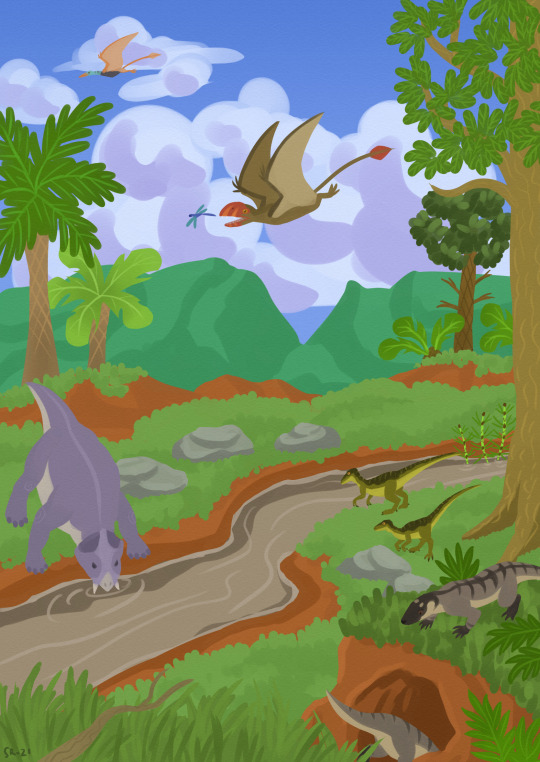
Scenic triassic views
#paleoart#triassic#cynodont#placerias#eoraptor#dinosaur#eudimorphodon#peteinosaurus#pterosaur#artblr
59 notes
·
View notes
Text
One paleoart for each period since the Cryogenian
Thanks to the timeline on my walls that I've been trying to fill in with my art, I have now reached the point where I've done paleoart for every single period of the Phanerozoic, plus the Ediacaran and Cryogenian! That is to say, every period of the last 700 million years. So with that milestone, I thought it'd be fun to go through those periods in order and show off one paleoart of mine for each!
Cryogenian
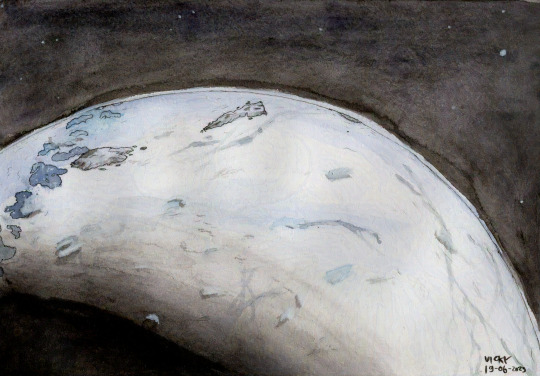
In the Cryogenian, the Earth completely froze over. Twice! Life wasn't much to look at yet, but I enjoyed drawing what our planet might have looked like at the time. The girdle of lakes at the left is the equator, which may have had ice-free patches.
Ediacaran
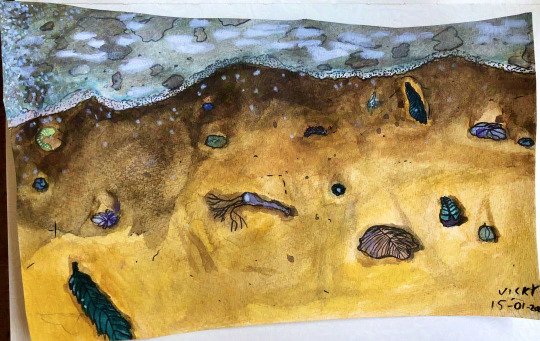
When the ice retreated, animals first began to blossom into their endless forms most beautiful. Ediacaran life was strange and quite unlike the creatures that would come later, but it was nonetheless an incredibly important chapter in life's history. Here we see the Ediacaran weirdos washing up on shore after a storm.
Cambrian

The Cambrian explosion brought much more recognisable creatures. But one thing that's easy to miss is that they were all tiny! All of them? No, Anomalocaris was, with a length of about 40 cm, the dragon of the Cambrian.
Ordovician

Life continued to diversify in the Ordovician, and among this diversity were the cephalopods. They produced the largest animals yet to exist, the orthocones, who hung vertically in the water column and decended upon their prey like a claw game.
Silurian
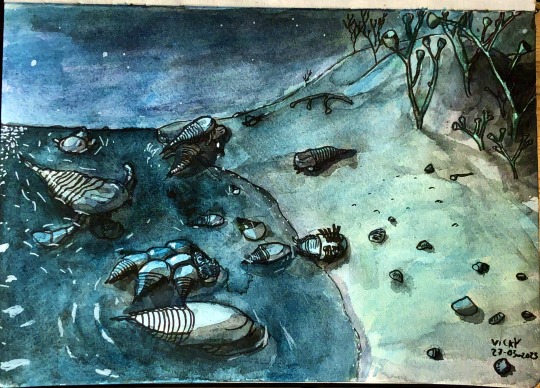
Although fungi and bacteria had already made forays onto the land deep in the past, things began to get busier there in the Silurian. But these horseshoe crabs, and their larger cousins the sea scorpions, have not come to the shore to stay, but to mate and lay eggs. Unfortunately for the horseshoe crabs, they have come to the very same shore.
Devonian
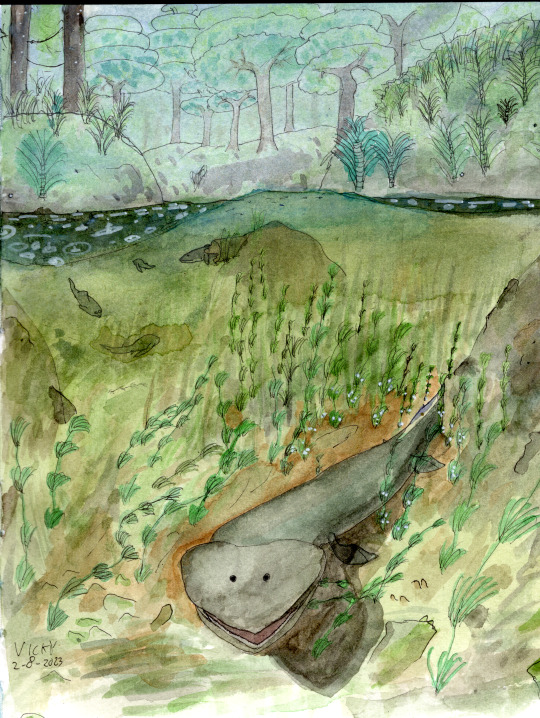
Our own vertebrate ancestors, like Tiktaalik, were pretty late to the party, only taking their first steps on land in the late Devonian. That's no knock against them - there was plenty to do underwater! This Tiktaalik is busy guarding his eggs while his mate is busy hunting, for example. Who has time to step on land?
Carboniferous
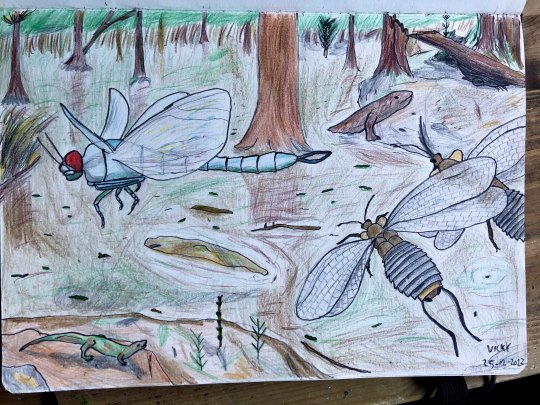
The end of the Carboniferous saw some quite large bugs, like these two Mazothairos chasing off an interloping Meganeura. They're representatives of a pretty interesting group of basal insects called the Palaeodictyoptera, who have a set of weird little extra wings on their thorax.
Permian

Among the many fantastic creatures of the Permian were our own cousins, the synapsids, like these lovey-dovey Moschops. As you can see, this picture and the previous one are done in coloured pencils instead of watercolour, because they're the oldest images I'm including in this post. I only very rarely used watercolours before this year. I think it means I should do some more Permian art, it's such a cool and underexposed period.
Triassic
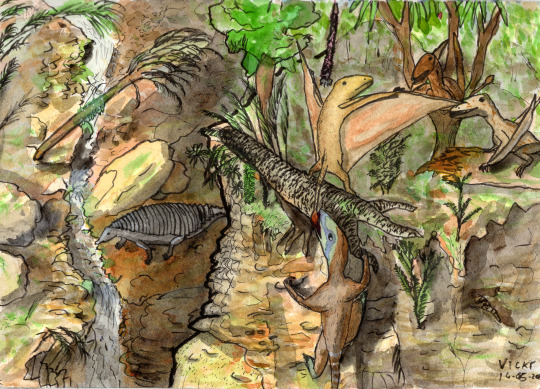
One mass extinction later, the archosaurs are diversifying all over Triassic Pangaea. Here we have the three main groups of them: Paratypothorax, a pseudosuchian in the background; Peteinosaurus, a pterosaur on top of the cliff; and Procompsognathus, a dinosaur climbing the cliff.
Jurassic

I had three different option for Jurassic paleoart to showcase, so I picked the most experimental one. These backlit insects are not butterflies, but kalligrammatids, a group of large-winged neuroptera, some of which even mimicked maniraptoran dinosaurs like this iridescent Caihong with their patterns.
Cretaceous
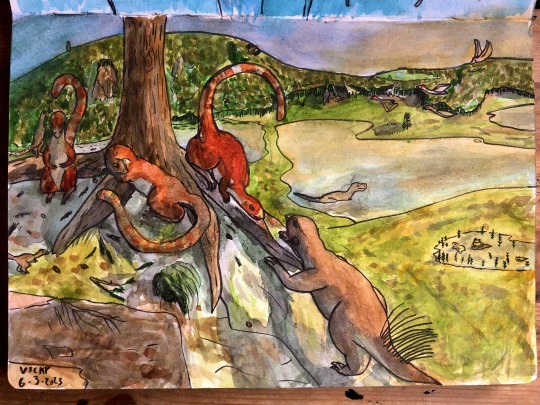
The Cretaceous featured some of life's most gorgeous crescendos of diversity, like the Yixian formation, where a Psitaccosaurus wants to visit the favourite tree of a group of Sinosauropteryxes, who are having none of it. This is still one of my favourite pieces I've ever drawn.
Paleogene
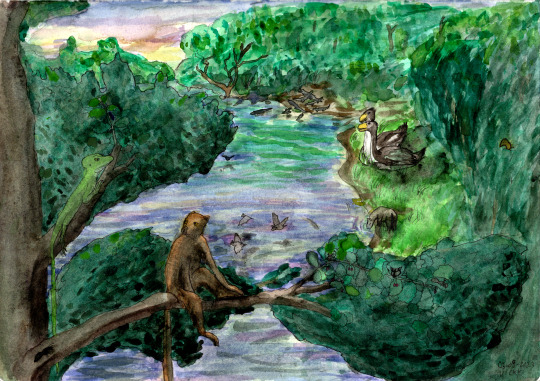
The Paleogene featured some of the highest global temperatures of all time, leading to tropical climates all over the planet, including at this lake in what will one day be Messel, Germany. Darwinius, a close cousin to our own ancestors, is having a staredown with the lizard Geiseltaliellus.
Neogene

The world turned colder and dryer in the Neogene, leading to the spread of large grasslands, like these South American ones. Phorusracos, a large terror bird, has caught a Thoatherium on the edge of the forest they both live in. South America was an isolated continent for the duration of the Neogene, leading to a quite unique fauna.
Quaternary

The Quaternary, our current period, is marked by the cycle of ice ages regularly freezing the northern hemisphere. But even during the ice ages, spring would come to the mammoth steppes, and these steppe mammoths are happy to celebrate its coming with a bath in the river.
#paleoart#my art#palaeoblr#timeline#no i am not gonna tag everything in it#the pictures should all work as links to the individual posts of these pieces#cw: animal death#cw: bugs#cw: parasites#cw: blood
309 notes
·
View notes